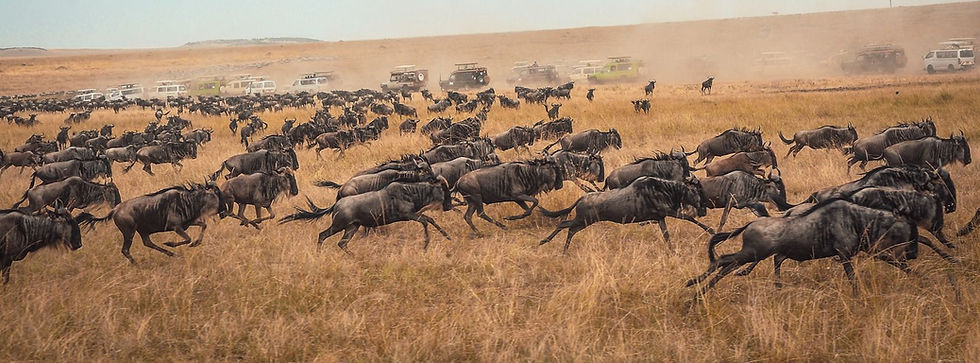The Great Wildebeest Migration
- Bryan Ronie
- May 7, 2022
- 4 min read

This spectacle is commonly referred to as “The Greatest Show in Africa” by wildlife enthusiasts. Many tourists travel yearly just to see the wildebeests cross over from Serengeti to Masai Mara. Some get lucky to spot the action, some not quite. The Great Migration is a highly fluctuating occurrence that you may or may not see, so find out below how you can actually see it.
In Which Month Can I Spot Wildebeest Crossing at The Mara River?
Many travelers believe that they can simply fly in to Masai Mara, spot the wildebeest crossing at the Mara River, and fly back home happy. Sorry to burst your bubble, it is not usually that linear as you might like to imagine. We know that the wildebeest will definitely cross the Mara River (along with some zebra and antelope) – but there is no telling exactly when it will happen.
The wildebeests don’t always immediately cross the river when they get there. Some lurk around for days grazing on grass, others return to Serengeti while others go for the plunge to the other side as soon as they arrive. The best antidote to this uncertainty is to have as much time as possible on safari.
This popular river crossing mostly happens between the months of June and October. Due to the drastic change in climate recently, the crossings could occur earlier or much later than anticipated. August is generally considered the most ideal month to see the dramatic action of the river. The Migration is not a one-time occurrence that happens within a few months, however. It is in actuality an on-going circular pattern with various amusing events all year round.

Where Does the Great Migration Begin?
As mentioned before, the migration is a fluid on-going process, therefore there is no definite commencement of the event. The migration is an army of around two million animals moving across the Serengeti-Mara ecosystem. It is believed that the process is triggered by East Africa’s rains and the animals go through the circular pattern to look for fresh pastures and water.
This incredible odyssey brings the wildebeests all the way through the Masai Mara plains in Kenya, across Tanzania’s Serengeti and the edges of Ngorongoro, before circling up in a clockwise direction. The animals are therefore always on the move, it’s only the river crossings that gets the most attention worldwide.
Activities That Happen During Migration
In the first month of the year, January, the herds are in Serengeti trekking into the area close to Lake Ndutu from the north-east region. As mid-February approaches it is now the calving season until March where about 8,000 wildebeest babies are born everyday. It is during this period that the Serengeti’s big cats get into action to get easy prey. The drama is surreal evoking feelings of sadness and thrill.
The herds start matching west slowly in March and the long rains start from April to May. Generally the herds move in a north-westerly direction towards the Moru and Simba Kopjes. During this period in April it’s now the breeding season where males compete unrelentingly for breeding rights.
Huge armies of wildebeests can be seen matching into central Serengeti from May. Now that the calves have grown stronger the speed of their migration increases substantially. In June herds begin to split up some already crossing the Grumeti River while others prepare for the incredible journey. By July the Great Migration is approaching the perilous waters of the Mara River which they have to get past to reach Kenya.
In August the wild spectacle of Mara River crossing is in full-fling. This month is considered the best for watching the sight but timing is key. It is advisable to spend as much time on safari as you can, like mentioned before, to it increase the probability of spotting it. Herds break off into smaller groups by September since not all of them cross over into Kenya to fight for their lives. The Masai Mara is idyllic to witness the herd migration during September and October.
Short rains start from November triggering the herds to depart the denuded Masai Mara grasslands back to Serengeti. The wildebeests migrate south for fresh grazing in December, covering north and eastern Serengeti and preparing for yet another cycle of drama.

What Time is Ideal for a Migration Safari?
Note firstly that both Masai Mara and Serengeti are generally great for wildlife encounters all year round. From the information above, you can tell that the timing of your safari depends by large with the events you would like to witness.
From February to March you can witness the calving season in Southern Serengeti. April to May is the breeding season in Western and Central Serengeti. Grumeti River crossings in Central Serengeti is perfect from May to June. Most visitors opt or the famous Mara River crossing in Northern Serengeti and Masai Mara which happens from July to August. To spot the Great Migration in the move is best from November to January in Masai Mara and Northern Serengeti to Southern Serengeti.
Facts Worth Noting
· The Great Migration is an ongoing process all year round
· River crossings are wildly unpredictable, however it is usually between June and September
· Most of the migration is in Serengeti
· Your best shot at spotting the wild spectacle is spending as much time as possible on safari
· The migration consists of large separate herds, not one huge army.










Comments